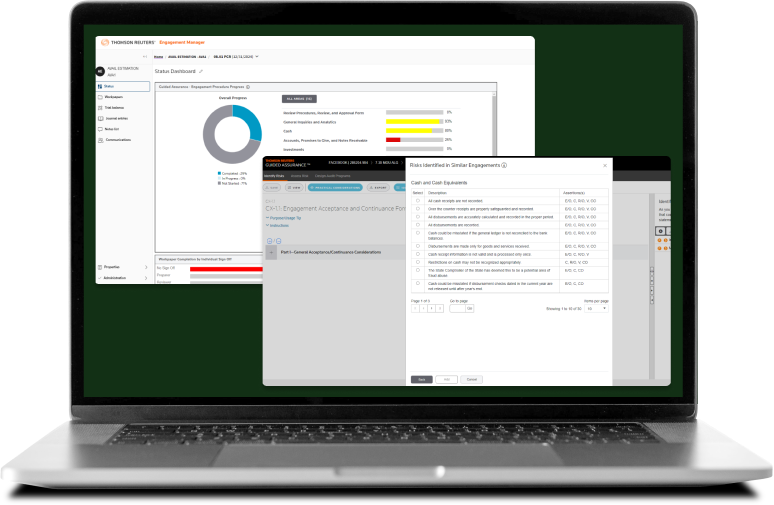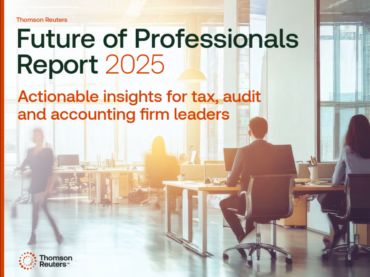Approaching 2025 and beyond requires a renewed commitment to evolution and innovation.
Audit firms face a unique set of challenges. The addition of policies such as environmental, social, and governance (ESG) create new areas of interest for stakeholders and investors, the shrinking talent pool has firms looking to improve workflow by automating processes, and an increasing focus on compliance measures are affecting both auditors and clients alike.
Jump to:
| Increased focus on ESG |
| Talent acquisition and retention |
| Technology and innovation |
| M&A activity |
| Ensuring compliance |
| Overcoming audit challenges |
Not only do audit firms have to navigate these concerns internally; but they also must address them in their client work. Amidst these challenges, one constant remains for auditors: the importance of identifying risk.
Let’s take a closer look at the top five areas of change in audit and how firms can overcome these challenges.
Increased focus on ESG
There are a number of issues and audit-related challenges around ESG that tax and accounting firms need to consider.
How is the growing focus on ESG affecting the audit profession?
Auditors are having to expand the scope of their work as ESG is increasingly under the scrutiny of stakeholders and investors. As an area that is still developing, and — from an audit and accounting standpoint — still in its infancy, it can feel a bit like the Wild West.
However, the need to deliver reporting on ESG is becoming a very serious business as it can affect everything from supplier selection, grants, and funding to valuations. Recent developments, particularly the introduction of mandatory reporting requirements for Scope 3 greenhouse gas emissions in California and the European Union by 2025, are creating new opportunities for audit firms of all sizes. This shift from voluntary to mandatory reporting is expected to significantly increase the demand for ESG-related auditing and attestation services.
What are some of the key challenges that audit firms face when auditing ESG disclosures?
Firms must either upskill their auditors or invest in new talent with the education and qualifications around ESG to ensure the proper engagements occur. Reporting can be fragmented, difficult to decipher, and has been an issue where no standard has existed before.
While the introduction of the International Sustainability Standards Board (ISSB) in November 2021 has set out to improve the comprehensiveness and quality of ESG reporting, firms still face challenges in adapting to evolving standards and meeting the growing demand for ESG-related auditing and attestation services. This is particularly crucial as major corporations increasingly seek assurance on their sustainability disclosures, with a significant majority planning to turn to CPA firms for these services.
Talent acquisition and retention
Attracting and retaining top talent in the tax and accounting industry can be a challenge. This is especially true as the demand for skilled auditors increases and competition from other firms and industries grows. Not to mention the fact that, in recent years, more tax professionals have exited the industry than entered it.
How has the demand for talent in the audit profession changed in recent years?
The exodus of experienced auditors, the shrinking talent pool of new auditors, and the changing expectations and skillsets required have led to a brain drain in the profession. The scope of work auditors are asked to perform is expanding to include providing assurance on reports and disclosures, navigating the omnipresence of seemingly infinite data sets, and working with new technology and tools.
To fill these gaps, recruiters are looking beyond traditional qualifications.
What are some of the potential risks and opportunities that emerging technologies pose to the talent pool in the audit profession?
The rise of emerging technologies presents an opportunity for auditors to expand their knowledge and service offerings by employing technology to do more of the heavy lifting. The flip side, however, is that the technology can be costly and disruptive to implement. Additionally, the need for continuing education and training requirements will continue to increase.
However, there is a bright spot in utilizing the power of cloud-based audit technology and AI to better identify risk and gain meaningful insight from the audit community — all without having to change your workflow. With cloud-based solutions giving teams the flexibility they need in the course of completing their work, and AI-powered technology helping them find the information they need to confidently complete it, firms have an enormous opportunity in terms of efficiency, productivity, and improved work-life balance for auditors.
Technology and innovation
With the rapid advancement of technology, auditors may find it challenging to keep up with new software tools and processes that are being used by clients, as well as adapt their own audit processes to remain efficient and effective.
How are audit firms leveraging technology to improve their audit processes and enhance the quality of their work?
In an effort to improve quality, quantity, productivity, and the bottom line, technology is a must have. Cloud-based systems streamline workflow and communication, which allows junior staff to help senior staff with audit tech, leading them to focus on higher-value tasks. Data and analytics are quickly synthesized with AI tools providing a greater degree of accuracy, improved insights, and risk identification.
By using AI to tap into the work of auditors who have faced a similar risk scenario, assisted decision-making can enhance the risk identification process with insight from the wider audit community.
When seeking the right cloud-based software, look for software that rapidly synthesizes data and analytics with AI tools, offering not just accuracy, but enhanced insights and robust risk identification. The right software should be a catalyst for efficiency, empowering your team to focus on what truly matters in your audit process.
 |
|
How can audit firms balance the need for innovation with the need for risk management and regulatory compliance?
Innovation using technology secures confidence in proven process-driven results to meet the growing demands for risk management and regulatory compliance. Audit firms must find a way to adapt by regulating digital reporting with business insights.
The answer may come in the form of assisted decision-making technology that can proactively present risks related to your engagement that you might not have thought of, enabling a faster and more confident audit.
How can new AI advancements help auditors?
AI is having a transformative impact on the audit profession. New developments in AI technology are making it possible for professionals to not only provide faster answers with confidence, but to also provide more meaningful insight with less work.
How generative AI can help auditors?
Generative AI serves as a powerful asset for audit professionals by boosting efficiency, accuracy, and creativity in their work. It can help to automate the creation of audit reports by efficiently summarizing extensive datasets and highlighting crucial findings, which saves time and minimizes human error.
Additionally, generative AI can produce synthetic data to augment existing datasets, allowing auditors to test various scenarios and validate models without risking sensitive information. By generating expected data patterns, AI aids in detecting anomalies or irregularities within financial data, thereby supporting fraud detection and risk assessment. Through natural language processing, generative AI can analyze and interpret unstructured data, such as emails and contracts, extracting relevant insights for audits. It can also enable auditors to simulate different financial scenarios and assess potential impacts, enhancing decision-making and strategic planning.
Finally, AI provides innovative solutions and suggestions for complex audit challenges, offering fresh perspectives and approaches. Thus, by leveraging generative AI, audit professionals can significantly enhance their analytical capabilities, streamline processes, and deliver more comprehensive and insightful audits.
Agentic AI in the audit profession
Agentic AI refers to artificial intelligence systems that possess a degree of autonomy, enabling them to make independent decisions and take actions to achieve specific goals or tasks. These systems are designed to operate with a level of self-direction, using data inputs and pre-programmed algorithms to navigate and interact with their environment.
Agentic AI can empower audit professionals by automating routine tasks, enhancing data accuracy, and offering deeper financial insights. It can efficiently handle data entry, transaction matching, and document review, allowing auditors to focus on complex activities.
By analyzing large data volumes, AI identifies patterns and anomalies, aiding fraud detection and risk assessment. Continuous compliance monitoring and real-time decision support further optimize audit planning and execution, boosting productivity and delivering greater value to clients and organizations.
M&A activity
With an increase in M&A activity expected in 2025, auditors may face challenges in managing the complexities of the transaction and ensuring that financial reporting is accurate and reliable.
How can audit firms help their clients navigate the challenges associated with M&A transactions?
As mergers and acquisitions become more complex, the accuracy of valuations and the ability to support the merging of financial systems and controls will require diverse knowledge of the technology and tools being used. The need for specialized knowledge in compliance, both within mergers and acquisitions as well as within industries, will grow. Internal control assessments, risk management, and post-merger performance will continue to play important roles.
In terms of risk identification, AI-powered analysis and assisted decision making can tap into the work of auditors who faced a similar risk and suggested risk areas you may not have thought of.
How can auditors ensure that the financial reporting associated with M&A transactions is accurate and reliable?
With the changing landscape, auditors will want to take a deep dive into their internal operations to evaluate their efficacy and quality. Developing new unique selling propositions based on new competencies will help them stand out from the crowd. Auditors might want to think about the impact of new factors such as ESG considerations, geopolitical uncertainties, and evolving regulatory environments on M&A transactions and their associated financial reporting.
Ensuring compliance
With an increase in M&A activity expected in 2025, auditors may face challenges in managing the complexities of the transaction and ensuring that financial reporting is accurate and reliable.
How can audit firms help their clients navigate the challenges associated with M&A transactions?
As mergers and acquisitions become more complex, the accuracy of valuations and the ability to support the merging of financial systems and controls will require diverse knowledge of the technology and tools being used. The need for specialized knowledge in compliance, both within mergers and acquisitions as well as within industries, will grow. Internal control assessments, risk management, and post-merger performance will continue to play important roles.
In terms of risk identification, AI-powered analysis and assisted decision making can tap into the work of auditors who faced a similar risk and suggested risk areas you may not have thought of.
How can auditors ensure that the financial reporting associated with M&A transactions is accurate and reliable?
With the changing landscape, auditors will want to take a deep dive into their internal operations to evaluate their efficacy and quality. Developing new unique selling propositions based on new competencies will help them stand out from the crowd. Auditors might want to think about the impact of new factors such as ESG considerations, geopolitical uncertainties, and evolving regulatory environments on M&A transactions and their associated financial reporting.
Overcoming audit challenges
Firms that embrace change and adopt a proactive approach to audit innovation will be in a better position for success in the years ahead. By leveraging technology, building diverse teams, and staying informed about regulatory developments, auditors can ensure they have provided the highest quality of service while staying ahead of the curve.
For more information on how to innovate, we offer a deeper look in our white paper 3 Keys to the Future of Audit | Thomson Reuters.
As you navigate the evolving landscape of audit challenges, experience the transformative power of Thomson Reuters Cloud Audit Suite. With seamlessly integrated assisted decision making and AI capabilities, empower your firm to effortlessly identify related risks and ensure your audit is conducted with confidence. Navigate audit challenges with ease — explore the future of auditing with the Cloud Audit Suite.








